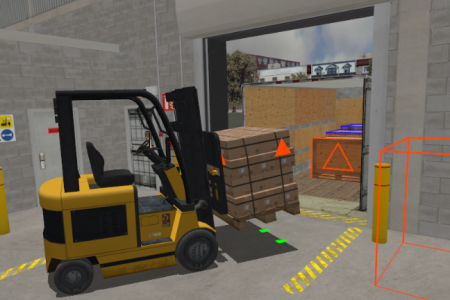Proficiency Starts with Zero Collisions During Training Simulation

As described in [1], learning any new skill, riding a bike or operating a lift truck, takes place in three stages:
- First, you work to understand what needs to be done, and focus on doing your best while avoiding “gross mistakes”, i.e. being careful.
- Later, after sufficient practice, you make fewer mistakes, performance is “smoother”, and you no longer focus as attentively; that’s “muscle memory”.
- Finally, training ends when you reach a safe and minimally competent level of performance.
In particular, deliberate practice means paying attention to different things at different times as you progress.
For lift trucks, that means first learning to move around safely, i.e. traveling forwards/backwards and steering while avoiding collisions.
Later, deliberate practice means paying more attention to how you pick up a load (are the forks perpendicular?), how you travel with the load (is the mast tilted back?), and how you place the load at its destination (is the “g force of load at impact” small, so the load won’t be damaged?).
Finally, you “speed up”, i.e. after enough “drill and practice”, you learn to do everything quickly while still working carefully.
Deliberate Practice at Work with Simlog’s Forklift Personal Simulator
Novelis is a world leader in aluminum rolling and recycling, and a global supplier of aluminum sheets used in the manufacturing of cars, airplanes, and cans for bottling soda and beer.
Headquartered in Atlanta GA, Novelis has over 40 plants all around the world.
At the Logan Aluminum plant in Kentucky (USA), onboarding a new lift truck operator begins with a “New Hire” class that includes a simulator-based introduction to lift truck operations. After that “orientation”, the new hire is assigned to a particular “team” in the plant for operator training that includes work at their Simlog Forklift Personal Simulator.
Training staff typically choose the “Loading Docks 1” Simulation Module that features the loading/unloading of a single “row” of standard-size palletized loads in a truck or trailer.
Practically, that means learning to:
- drive forwards and backwards, and master the rear-wheel steering
- safely enter and exit the truck or trailer, with and without a load
- work with the forks to pick up and put down the palletized loads at designated locations
(Subsequent “Loading Docks” modules make the loading and unloading work more difficult, with stacking and unstacking smaller loads arranged in double rows.)
Training Simulation Proficiency Starts with Zero Collisions
At Logan Aluminum, the operator training focus is on safety from the get-go and for that reason, counting collisions (or rather the absence of collisions) is how the training staff decides that a new hire has become minimally proficient (at the simulator), i.e. that the new hire has learned to work in the simulated world well enough, i.e. carefully and quickly, and is therefore ready to “graduate” to real world work.
Practically, for “Loading Docks 1”, the Simlog’s simulation software counts 20 different kinds of collisions that can occur (in the simulated world), as follows:
- a fork with the floor, a load, a rack, a shelf, an obstacle, or the truck or trailer (6 kinds of collisions)
- a load with another load, a rack, a shelf, an obstacle, or the truck or trailer (5 kinds of collisions)
- the mast with a rack, a shelf, an obstacle, or the truck or trailer (4 kinds of collisions)
- the forklift chassis with a load, a rack, a shelf, an obstacle, or the truck or trailer (5 kinds of collisions)
So “zero collisions” means zero across the board, i.e. none of the 20 different kinds of collisions occur.
References
[1] K. Anders Ericsson, “The Influence of Experience and Deliberate Practice on the Development of Superior Expert Performance”, Chapter 18, The Cambridge Handbook of Expertise and Expert Performance, Cambridge University Press, June 2006.

